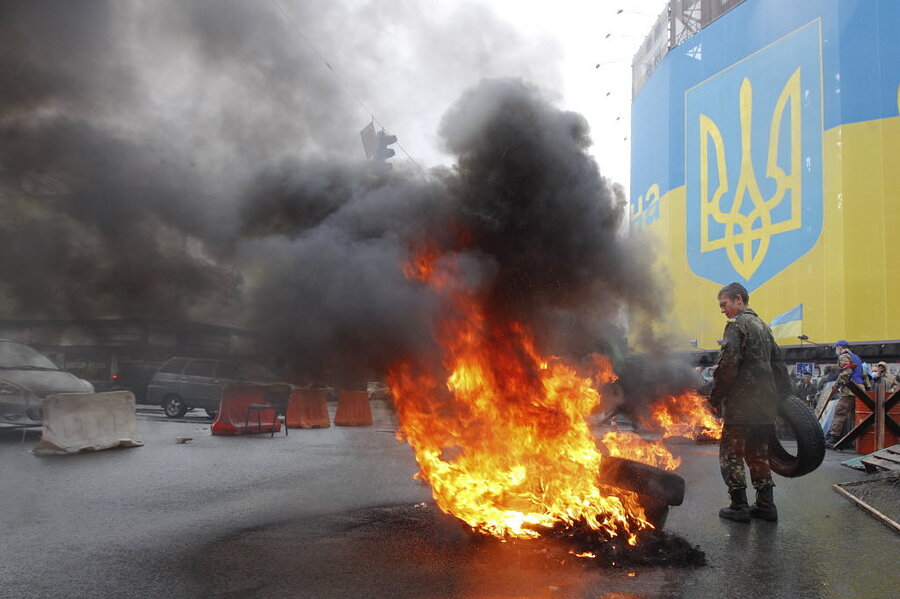Some Kiev barricades come down, but protesters 'have no plans to leave'
Loading...
| KIEV, Ukraine
Demonstrators on the main downtown avenue of Ukraine's capital set piles of tires ablaze on Saturday to protest authorities' call to end the encampment that began six months ago. A few hundred meters away, workers in hard hats cleared debris from torn-down barricades.
The contrasting scenes on Kreshchatik Street in Kiev highlighted some of the many uncertainties facing Ukraine. Even after the May 25 election for a president to replace the interim leader who took power amid chaos in February, many Ukrainians remain deeply suspicious of the government, and several hundred are still holding out at a vast protest camp.
Three months of protests during the winter eventually drove pro-Russia president Viktor Yanukovych to flee the country. But the extensive protest tent camp and the barricades of wooden pallets, tires, and trash that protected the camp remained even after interim president Oleksandr Turchynov was appointed.
The holdouts say they want to keep up the encampment until the new government and president-elect Petro Poroshenko carry out important reforms in a country long riddled by corruption.
"Personally, I have no plans to leave. They need to show the people that the new laws are working – they're where they are thanks to us," said demonstrator Anna Chaikovska, from the Rivna region in western Ukraine.
Newly-elected Kiev mayor Vitali Klitschko, the former world heavyweight boxing champion, has called on the demonstrators to fold up their tents and go home. But aside from removing some of the barricades, authorities have taken little action.
Russia has repeatedly criticized the Ukrainian authorities for failing to clear out the encampment and free buildings occupied by demonstrators, which was among the terms stated in an agreement reached between Russia, Ukraine, the United States, and the European Union in April aimed at cooling tensions in Ukraine's crisis.
In Ukraine's east, where separatists have declared two provinces independent and are fighting government forces, many are deeply suspicious of the Kiev demonstrations and the new government they have propelled to power.
The conflict between government forces and the insurgents in the east escalated markedly in the last week, including rebels' attempt to seize the airport in the city of Donetsk on Monday and the shooting down of a Ukrainian military helicopter on Thursday. Twelve people, including a general, died in that incident.
On Saturday, Russia's Foreign Ministry criticized a suggestion by an official from the Organization for Security and Cooperation in Europe that it could withdraw its observer mission from Ukraine because of safety concerns, as shooting between government troops and pro-Russian rebels continued in the region.
The international monitoring body says it lost contact on Thursday with a group of five monitors in separatist eastern Ukraine. Another four-member team has been held by eastern rebels since Monday.
Wolfgang Ischinger, the OSCE's negotiator on national dialogue in Ukraine, told German broadcaster ZDF this week that the monitor mission might have to withdraw if the organization fears for its employees' lives.
But the Russian ministry said in a statement Saturday that "amid Kiev's intentionally intensified punitive operation in the east of the country, it is essential to step up the work of international observers."
Confrontations continued Saturday between government troops and the rebels, who have seized administrative and police buildings across the east and want to join the region to Russia.
At a government-controlled checkpoint in the city of Slovyansk, which has been the epicenter of the conflict, troops came under fire but repelled the attack. No casualties were reported in the latest attempt to break the army's ring of checkpoints around the city.
Vladislav Seleznev, press secretary for Ukraine's anti-insurgent operation in the east, said Saturday that the army had successfully destroyed a cannon in Slovyansk, which he said rebels had been using to shell civilian buildings in the town.
As violence escalated in the region, the Ukrainian and pro-Russian sides have blamed each other for the rising number of civilian casualties in the conflict.
Heintz reported from Moscow. Efrem Lutasky in Slovyansk, Ukraine contributed to this report.
Copyright 2014 The Associated Press. All rights reserved. This material may not be published, broadcast, rewritten or redistributed.







